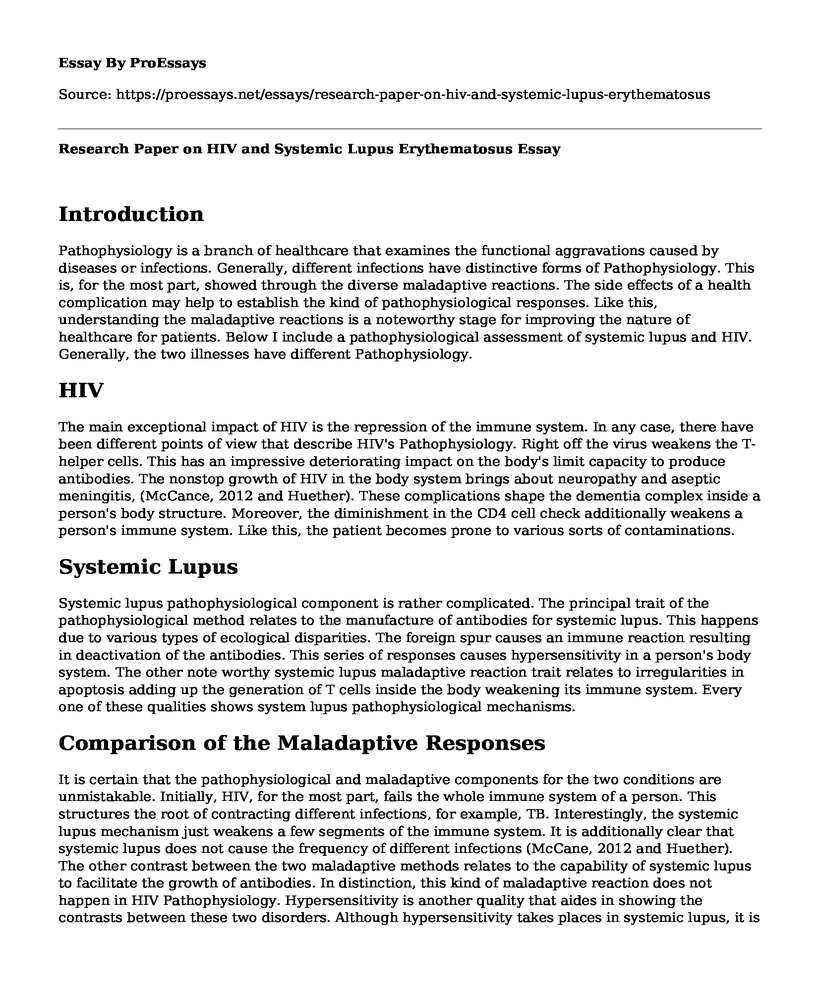Introduction
Pathophysiology is a branch of healthcare that examines the functional aggravations caused by diseases or infections. Generally, different infections have distinctive forms of Pathophysiology. This is, for the most part, showed through the diverse maladaptive reactions. The side effects of a health complication may help to establish the kind of pathophysiological responses. Like this, understanding the maladaptive reactions is a noteworthy stage for improving the nature of healthcare for patients. Below I include a pathophysiological assessment of systemic lupus and HIV. Generally, the two illnesses have different Pathophysiology.
HIV
The main exceptional impact of HIV is the repression of the immune system. In any case, there have been different points of view that describe HIV's Pathophysiology. Right off the virus weakens the T-helper cells. This has an impressive deteriorating impact on the body's limit capacity to produce antibodies. The nonstop growth of HIV in the body system brings about neuropathy and aseptic meningitis, (McCance, 2012 and Huether). These complications shape the dementia complex inside a person's body structure. Moreover, the diminishment in the CD4 cell check additionally weakens a person's immune system. Like this, the patient becomes prone to various sorts of contaminations.
Systemic Lupus
Systemic lupus pathophysiological component is rather complicated. The principal trait of the pathophysiological method relates to the manufacture of antibodies for systemic lupus. This happens due to various types of ecological disparities. The foreign spur causes an immune reaction resulting in deactivation of the antibodies. This series of responses causes hypersensitivity in a person's body system. The other note worthy systemic lupus maladaptive reaction trait relates to irregularities in apoptosis adding up the generation of T cells inside the body weakening its immune system. Every one of these qualities shows system lupus pathophysiological mechanisms.
Comparison of the Maladaptive Responses
It is certain that the pathophysiological and maladaptive components for the two conditions are unmistakable. Initially, HIV, for the most part, fails the whole immune system of a person. This structures the root of contracting different infections, for example, TB. Interestingly, the systemic lupus mechanism just weakens a few segments of the immune system. It is additionally clear that systemic lupus does not cause the frequency of different infections (McCane, 2012 and Huether). The other contrast between the two maladaptive methods relates to the capability of systemic lupus to facilitate the growth of antibodies. In distinction, this kind of maladaptive reaction does not happen in HIV Pathophysiology. Hypersensitivity is another quality that aides in showing the contrasts between these two disorders. Although hypersensitivity takes places in systemic lupus, it is missing in the HIV maladaptive reaction.
Impacts
The primary factor that influences these diseases to progress within a person's body system is genetic qualities. This attribute has a characteristic ability to impact the rate at which a disease crashes the immune system of a person. From the viewpoint of HIV maladaptive components, genetic qualities impact the rate at which the infection immune system. While the reactions may be showed rapidly in a few people, the circumstance is distinctive in different people. Genetics have similar implications on systemic lupus, contrasted with HIV.
References
Jones, C. (2012). Understanding Pathophysiology. 5th Edition Sue E Huether and Kathryn L McCance (2012) 1159 pages Elsevier: ISBN 978-0-323-07891-7 Cost: PS67.99. Journal OfRenalNursing, 4(2),108-108. https://books.google.com/books/about/Understanding_Pathophysiology.html?id=F0c3kgEACAAJ
Illei, G., Dang, D., & Pucino, F. (2002). Book Review: Dubois' Lupus Erythematosus, 6th EditionDubois' Lupus Erythematosus, 6th Edition, Edited by WallaceDaniel J MD and HahnBevra Hannahs MD. Published by Lippincott Williams & Wilkins, Philadelphia, PA, 2002. ISBN 0-7817-2464-3. Clothbound, xiii + 1348 pp. (28.5 22.5 cm), $199. www.lww.com. Annals Of Pharmacotherapy, 36(6), https://www.abebooks.com ' ... ' Wallace, Daniel J. & Hahn, Bevra Hannahs (Editors)
Itoh, K., Nishioka, Y., Hirohata, S., Inoue, T., Ito, K., Kimura, M., & Mori, S. (1994). HIV Induced Systemic Lupus Erythematosus. Lupus, 3(3), 205-206 https://journals.lww.com/mdjournal/fulltext/2017/12220/Concomitant_systemic_lupus_erythematosus_and_HIV.100.aspx
Cite this page
Research Paper on HIV and Systemic Lupus Erythematosus. (2022, Jun 10). Retrieved from https://proessays.net/essays/research-paper-on-hiv-and-systemic-lupus-erythematosus
If you are the original author of this essay and no longer wish to have it published on the ProEssays website, please click below to request its removal:
- Research Paper on Drinking Alcohol During Pregnancy
- Research Paper on Compensation Issues in Nursing and Staff Shortage
- Marijuana Debate in Healthcare Essay Example
- Nurse Practitioners: Supporting Health Demands of the Population - Essay Sample
- Essay Example on COVID-19: Global Pandemic Threatens Nations Worldwide
- Essay Example on COVID-19: Identifying the Problem Before Opening the Unit
- Report Example on Combating Obesity: A Proposal for a Sustainable Solution







